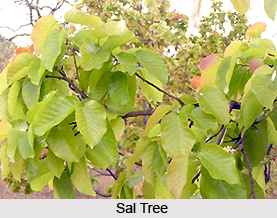 Sala is known in Botany as Shorea robusta Gaertn. This Indian medicinal plant is grown in the sub-Himalayan tract at an altitude of 1700 meters. It is usually found from Punjab to Assam, southwards through West Bengal, Bihar and Orissa into Andhra Pradesh and Madhya Pradesh. Sala is referred with various other names in different parts of India like in Bengali: Sakhu, Sal, Sala, Salwa; in English Sal, Indian Dammer; in Gujarati Ral, Rala (Resin); in Hindi Sakhu, Sal, Sala, Shal; in Kannada Asina, Guggula, Kabba (Resin), Sarja, Vamsa; in Malayalam Maramaram (Resin), Mulappumarutu; in Marathi Guggilu, Ral, Rala (Resin), Sajara; in Oriya Sagua, Sal, Salwa, Sekwa, Soringhi; in Punjabi Sal, Serai; Sanskrit: Sala, Salah; in Tamil Attam, Kungiliyam (Resin), Shalam; in Telugu Gugal, Guggilamu (Resin), Sarjamu; and in Urdu Ral.
Sala is known in Botany as Shorea robusta Gaertn. This Indian medicinal plant is grown in the sub-Himalayan tract at an altitude of 1700 meters. It is usually found from Punjab to Assam, southwards through West Bengal, Bihar and Orissa into Andhra Pradesh and Madhya Pradesh. Sala is referred with various other names in different parts of India like in Bengali: Sakhu, Sal, Sala, Salwa; in English Sal, Indian Dammer; in Gujarati Ral, Rala (Resin); in Hindi Sakhu, Sal, Sala, Shal; in Kannada Asina, Guggula, Kabba (Resin), Sarja, Vamsa; in Malayalam Maramaram (Resin), Mulappumarutu; in Marathi Guggilu, Ral, Rala (Resin), Sajara; in Oriya Sagua, Sal, Salwa, Sekwa, Soringhi; in Punjabi Sal, Serai; Sanskrit: Sala, Salah; in Tamil Attam, Kungiliyam (Resin), Shalam; in Telugu Gugal, Guggilamu (Resin), Sarjamu; and in Urdu Ral.
Bark of the Sala plant is reddish brown or grey in colour, smooth and is longitudinally fissured. Sala has ovate oblong, coriaceous leaves which become lustrous when matured. Fruit of this plant is indehiscent, ovoid, reddish to pale yellowish-green in colour, wing like with persistent sepals. The Sala seeds are ovoid, with unequal fleshy cotyledons. Sala plant flowers in March and April while its fruits mature between May and July. In central India the Sala tree remains leafless for a short duration between February and April.
The leaves of this Sala, an Indian medicinal plant, are known in Ayurveda as anthelmintic and alexiteric. These leaves are used to cure wounds and ulcers, itching, leprosy, gonorrhoea, cough, earache and headache. Oleoresin with astringent and detergent properties is obtained from the cut bark of Sala trees which is used in treating ailments like diarrhoea, dysentery and vaginal discharges. This Sala oleoresin also heals wounds, ulcers, fractures and soothes burns and itchings. According to Unani medicine this oleoresin is capable of treating menorrhagia, enlargement of the spleen and eye irritations. The Sala resin is utilized as an ingredient of ointments for ear problems and skin diseases. The tribal inhabitants of southern Bihar and the Kondhs of southwestern Orissa use the powdered stem bark or bark paste of this Sala tree to stop bleeding and promote healing of cuts. This Sala bark is considered as an aphrodisiac and is used in treatment of gonorrhoea. The Sala tree yields good timber. The Sala resin is applied as incense in India. This Sala resin is also utilized for caulking boats and producing inferior quality varnishes and paints.











